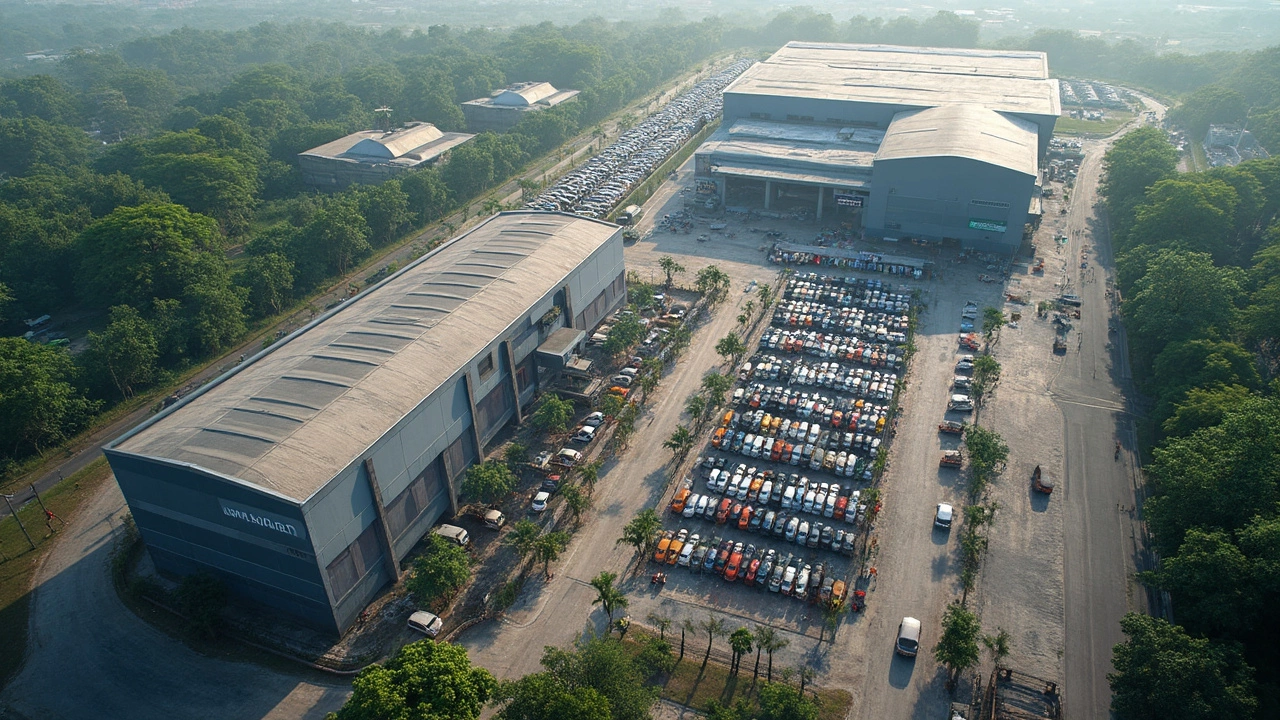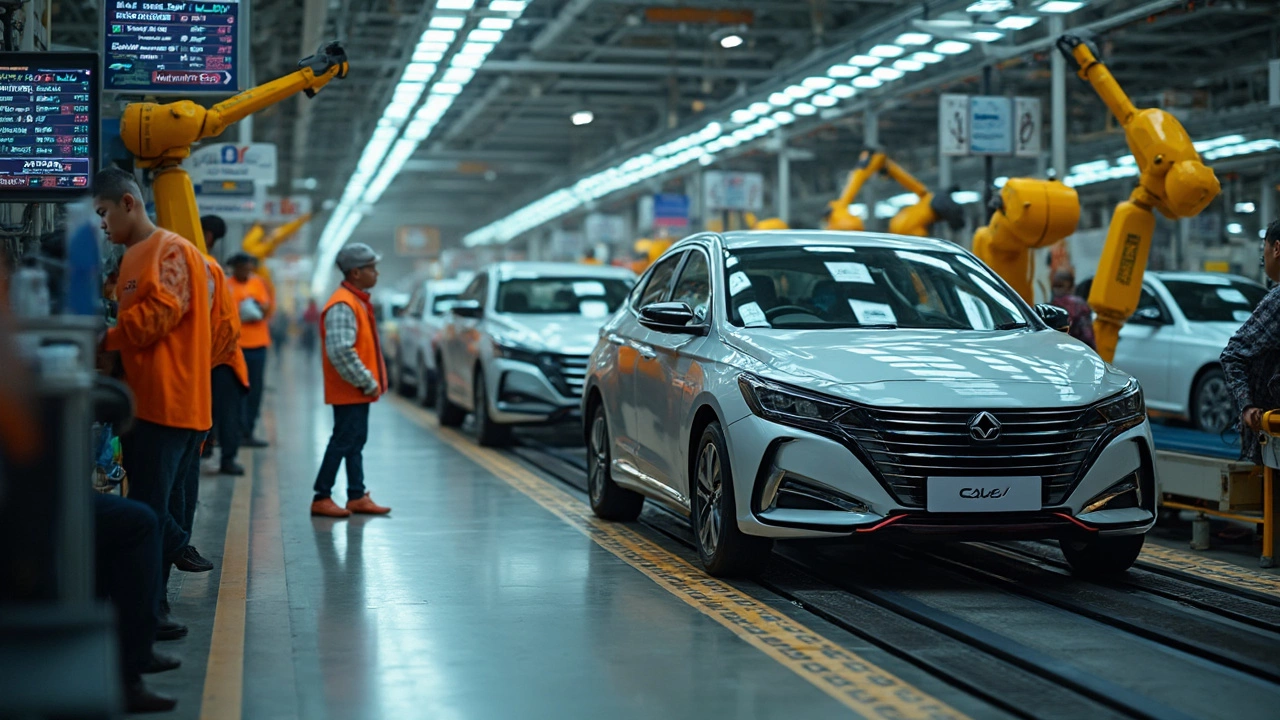 Jun, 3 2025
Jun, 3 2025
If you try picturing the biggest car plant in India, think bigger. The Maruti Suzuki plant in Manesar, Haryana isn’t just a giant—it’s a city sized around cars. Here, you’ll see over 7,000 workers and robots churning out vehicles at a jaw-dropping pace. Every minute, there’s a car rolling off the line, ready to hit Indian streets. This place covers almost 600 acres, so if you tried walking the length, you’d probably need a break and a snack along the way.
What’s wild? At peak speed, this plant alone can put together close to 5,500 cars a day. No other auto plant in India pulls off those numbers. Even if you stack up other giants like Hyundai in Chennai or Tata in Pune, Manesar still wins by a solid margin. The reason? Maruti Suzuki nailed the formula: lean manufacturing, tight efficiency, and a serious hunger to meet India’s crazy demand for cars like the Swift and Dzire.
- India’s Giant: The Biggest Car Manufacturing Plant
- Unpacking the Scale: How Big is Big?
- Life Inside the Production Line
- Surprising Details and Industry Tips
India’s Giant: The Biggest Car Manufacturing Plant
If you talk about big car factories in India, nothing beats the largest car plant India has ever built: the Maruti Suzuki Manesar plant in Haryana. This place is no small fry—it’s a hub that changed the game for car production in the country. Maruti Suzuki didn’t pick Haryana by accident. The area’s close to suppliers, has solid road connections, and plenty of skilled workers in the region.
The Manesar plant started rolling in 2007 but has kept growing. Today, it stretches over about 600 acres, almost the size of several mall complexes put together. With three main assembly lines and dozens of smaller support lines, the plant can spit out around 5,500 cars every single day when running at full tilt. That’s more than two lakh cars each month—that’s actually more cars than many countries’ entire annual output.
This factory is the core of Maruti Suzuki’s network, supplying not just Indian markets but also sending thousands of cars abroad to over 100 countries. So, it’s not just about local demand—think global reach. Maruti churns out their popular models here, like the Swift, Dzire, and Ertiga.
What really makes this plant stand out isn’t just its size, though. Everything is built for speed and efficiency. Robots handle a chunk of jobs—welding, painting, and even moving car parts from one spot to another. But humans run the tricky stuff, especially parts that need eyes and hands on the job. It’s a blend of automation and human skill you don’t see at just any factory.
If you’re curious about pure numbers, here’s a fun one: when working flat out, the plant uses enough wiring to connect Delhi to Jaipur—seriously. And its test track inside is long enough for a solid test drive, so no car leaves without getting checked. That’s company culture—they really sweat the small stuff here.
Unpacking the Scale: How Big is Big?
So, how huge is the Maruti Suzuki Manesar plant really? This isn’t your average factory. The plant covers about 600 acres—bigger than many college campuses and enough space to fit around 280 football fields. Walking from one end to the other isn’t something you’d want to do in a rush.
Let’s put the numbers out there. The Manesar plant’s total installed capacity is around 900,000 cars per year, just from this one site. To put it in perspective, if you parked every car made in one year bumper to bumper, the line would stretch over 1,000 kilometers. It even includes its own power generation, paint shops, engine assembly lines, and testing tracks, so the whole process runs in one place—no constant trucking parts in and out.
Here’s how the big Indian auto plants compare when it comes to output and space:
| Plant Name | City | Annual Capacity (Cars) | Area (Acres) |
|---|---|---|---|
| Maruti Suzuki Manesar | Manesar | 900,000 | 600 |
| Hyundai Motor India | Chennai | 750,000 | 535 |
| Tata Motors Pune | Pune | 450,000 | 800 |
| Honda Cars India | Greater Noida | 240,000 | 450 |
Even if another plant takes up more space (looking at you, Tata Pune), no one matches the volume of vehicles rolling out at Manesar. The combination of production capacity and output makes it the largest car plant in India by miles.
If you’re ever nearby, just watch the trainloads of new cars headed out daily. This scale isn’t just good for breaking records—it helps keep wait times low and prices competitive. And when a factory can pump out nearly a million cars a year, you know they’ve tuned their process to near perfection.

Life Inside the Production Line
Walking through the Maruti Suzuki Manesar plant, you instantly notice that it’s less chaos and more like a perfectly timed orchestra. Everything here is about speed and precision, with workers and machines moving in sync. On a typical shift, over 7,000 employees work alongside several hundred robots. Each robot can do the work of four or five people, welding body panels and mounting parts at lightning speed.
Every vehicle travels down the assembly line in carefully timed stages. First, the painted bodies move into the trim shop, where dashboards, seats, and electronics slot into position. After that, it’s the chassis line, where engines are installed, wheels get fitted, and the entire car starts to look like, well, something you’d actually want to drive.
Quality checks happen at several points—not just at the end. There are teams assigned to check everything from door alignment to wiring. If one tiny problem pops up, they can stop the whole line. That’s rare, though, because the plant follows a ‘Just in Time’ strategy. It means parts arrive exactly when needed, cutting down on wasted space and mistakes.
If you’re looking to understand how the largest car plant India keeps things on track, it all comes down to tight discipline and tech upgrades. There’s a central control room monitoring production, safety, and even energy use. If someone finds a snag, there’s a simple button system right at their station to alert supervisors in seconds. This keeps the pace steady and minimizes downtime.
What’s cool for car geeks—at any time, you might see new technology rolling out. For instance, Maruti Suzuki started using AI cameras for real-time paint inspection. That means less waste, better colors, and catching flaws before they reach buyers. Workers regularly get updated training so everyone’s on the same page, whether it’s for using power tools or running checklists with tablets.
The result of all this smart planning? A new car rolls off the line every 12-14 seconds. It’s pretty wild to see, and that’s what keeps Maruti Suzuki at the top of the Indian auto game.
Surprising Details and Industry Tips
Everyone knows the Manesar plant is massive, but some behind-the-scenes facts still drop jaws. For starters, the facility runs almost nonstop—nearly 350 days a year. The factory only shuts for maintenance or those big Indian holidays when even machines deserve a rest. This relentless work ethic is actually what keeps Maruti Suzuki parked at the top spot in the largest car plant India sweepstakes.
Here’s something else: Some sections of the Manesar plant can assemble a car in just under 40 seconds. That’s less time than it takes to heat up a quick snack in your microwave. The plant’s paint shop alone covers an area bigger than seven football fields, and it handles custom colors and finishes with insane precision. Also, if you spot a Swift zipping down the street, odds are better than 1-in-2 that it’s from Manesar—more than half of India’s Swifts come right out of this place.
If you geek out on numbers, this table sums up just how much ground Manesar covers:
| Fact | Detail |
|---|---|
| Total Area | 600 acres |
| Daily Output | Up to 5,500 cars |
| Total Employees | 7,000+ |
| Most Produced Model | Maruti Suzuki Swift |
| Operational Days/Year | ~350 days |
Another cool bit: The plant’s power-saving tricks are legendary. Solar arrays and energy-efficient lighting cut electricity bills by around 10% every year. Even paint fumes don’t go to waste—they’re scrubbed and reused for heating.
Want the inside line on what sets Indian auto factories apart? Better reliability. Indian plants, especially Manesar, keep downtime super low by following something called "Jidoka"—it means if even the tiniest glitch pops up, the whole line stops for an instant fix. A senior engineer from Maruti Suzuki once told Reuters,
"Our goal is zero downtime, zero defects. The robots and workers are trained to spot problems in seconds. That's the real magic behind these huge numbers."
If you’re thinking of visiting or working at a plant like this, here are some quick tips:
- Wear sturdy shoes. It's a hike from one line to another.
- Noise-cancelling headphones will be your best friend—those stamping machines aren’t quiet.
- Double-check safety protocols. Every zone has its own rules, from clothing to where you can walk.
- Keep your phone handy for QR-based visitor guides inside the factory, but don’t try to sneak photos without a permit.
There’s a good reason Maruti Suzuki Manesar keeps breaking records: it stays a step ahead on tech, people, and mad attention to detail.